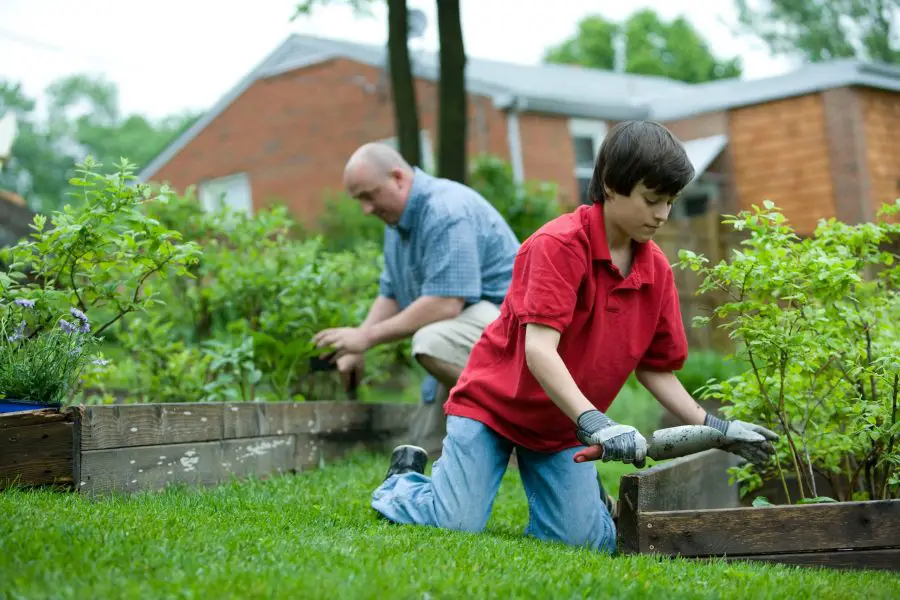Gardening has been shown to have a positive impact on health, both physical and mental. Here are some of the ways that gardening can promote health:
Gardening is exercise
After my knee injury, I had to rest for two months. Once I was allowed to move around, I started to do some light gardening chores. Although it was a light and careful activity, you would not believe how sore I was after that.
Gardening is a form of exercise involving a variety of movements, such as bending, squatting, lifting weights, kneeling, and others. These activities use different muscle groups. As a low-impact workout for the whole body, helping improve cardiovascular health, strength, and flexibility.
According to the (CDC), gardening is a moderate-intensity physical activity. It can promote health and help prevent diseases, such as heart disease, obesity, and diabetes. It is also an enjoyable way to burn calories. Gardening for 30-45 minutes every day helps burn calories and improve endurance.
Gardening as a means of stress management
When it comes to reducing stress and anxiety, promoting relaxation, and improving mood, gardening can be rewarding. An activity that provides opportunities to connect with nature, learn new skills, and create a sense of accomplishment enhances self-confidence.
Also, spending time in nature and focusing on the task at hand can have a meditative effect on the mind and body.
Weeding, for example, can be a great way to calm your nerves in stressful situations. More intense activities, such as digging or chopping tree limbs, can be a way to release negative energy like anger.
Grounding or earthing is a practice that involves walking barefoot or touching the soil with your hands. The idea is that the earth has a natural electrical charge that can help balance the boy’s electrical charge. By doing so we can reduce inflammation, anxiety, and stress.

Boost your immune system by gardening
Gardening provides an opportunity to get outside and breathe fresh air, which can help to improve respiratory health. It also allows us to spend time in the sun, boosting vitamin D levels, which is essential for immune function and bone health.
Exposure to soil microbes while gardening can help reduce the risk of allergies and autoimmune diseases. Soil microbes have a beneficial effect on the immune system by promoting the production of white blood cells, therefore reducing inflammation.
In addition, getting stung by bugs also improves your immune response as long as you do not suffer from severe allergies. In my early days of gardening, fire ants always got me, causing my skin to painfully blister. Nowadays, I only feel the pain of the bite and that’s about it.
Gardening promotes healthy eating
Gardening can be a great way to promote healthy eating habits by providing access to fresh, organic produce that is free from harmful chemicals and pesticides. It provides an opportunity to consume seasonal fresh fruits, vegetables, and herbs that are packed with vitamins, minerals, and antioxidants.
Gardening provides an opportunity to learn about different varieties of fruits and vegetables. It helps open your mind to new sources of food. If you do not like one, you would another.
Easting what the season offers allows the body to get the necessary nutrients when needed. Check out my other post on eating in season to learn more.
Eating a variety of fruits and vegetables is essential for maintaining good health and can help reduce the risk of nutrient deficiencies.
Gardening can also help reduce reliance on processed foods by providing access to fresh produce that can be used to prepare healthy meals.
Promotes eating locally grown produce supporting local agriculture and the local economy. It also teaches children about healthy eating in a fun way.

Gardening can keep your brain young
Many studies have shown that gardening can be a great brain stimulator. It engages the mind and body, requiring us to use a wide range of cognitive skills such as planning, problem-solving, and critical thinking.
In a study performed by Korean researchers on “Determining the Effects of Horticultural Activity Program as a Physical Activity for Improving Cognitive Function of Elderly”, it was found that “Participants in the present study exhibited significantly increased levels of the brain nerve growth factors.”1
However, this study used short-term gardening activities. Future work needs to determine if prolonged gardening practices have greater effects.
Ditch loneliness
Moreover, as mentioned previously, gardening helps reduce stress and anxiety. Therefore positively impacting our overall cognitive function. Whether it is planting flowers, growing vegetables, or just tending to the garden, spending time outside in nature and engaging in this type of activity can benefit your brain health.
Many cities and towns have community gardens where people can come together to plant and tend to a shared plot of land. This not only provides an opportunity for people to grow their food but also fosters a sense of community and social interaction. It is also a way to build and strengthen community connections.
Usually, in a community garden, people come from different backgrounds, enriching each other’s cultural knowledge by learning about people’s cuisines.
Gardening can be a great way to meet new people, share knowledge and skills, and work towards a common goal.
Additionally, community gardens often serve as a source of fresh produce for local food banks and other organizations that help those in need, making gardening a powerful tool for promoting social and environmental justice.
Even if you are an introvert, gardening tends to help with getting out of your shell. Gardeners generally are down-to-earth people. (no pun intended)
- Park, A., Lee, Y., Park, G., & Lee, L. (2019). Benefits of Gardening Activities for Cognitive Function According to Measurement of Brain Nerve Growth Factor Levels. International Journal of Environmental Research and Public Health, 16(5). https://doi.org/10.3390/ijerph16050760 ↩︎




